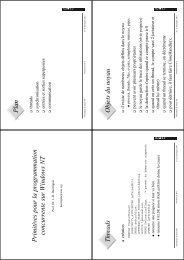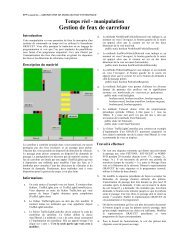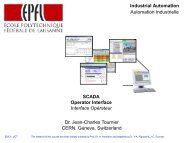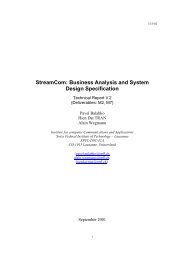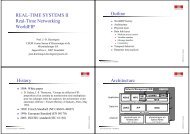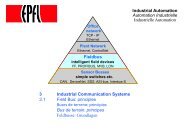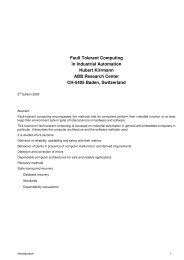GRAFCET and Petri Nets Outline Introduction GRAFCET - EPFL
GRAFCET and Petri Nets Outline Introduction GRAFCET - EPFL
GRAFCET and Petri Nets Outline Introduction GRAFCET - EPFL
You also want an ePaper? Increase the reach of your titles
YUMPU automatically turns print PDFs into web optimized ePapers that Google loves.
Graph interpretation<br />
2 persons in front of the same graph <strong>and</strong> assuming the<br />
same sequence of inputs should deduce the same<br />
sequence of outputs.<br />
Asumptions:<br />
2 uncorelated events may not occur at the same time<br />
The graph has enough time to reach a stable state before the<br />
occurrence of the next event<br />
Interpretation Algorithm (without<br />
stability search)<br />
1. Read the state of the inputs<br />
2. evolve (one or more<br />
simultaneous clearings)<br />
3. Execute actions<br />
4. goto 1<br />
a<br />
c<br />
b<br />
(1) ↑b<br />
7 G<br />
(4) c<br />
d<br />
1<br />
(5)<br />
(7)<br />
5<br />
H D<br />
(2)<br />
↑b<br />
c<br />
G<br />
3<br />
↑a<br />
D<br />
(6)<br />
(8)<br />
(3)<br />
6<br />
2<br />
4<br />
=1<br />
d<br />
D<br />
m.a'<br />
G<br />
H<br />
D<br />
Real-Time Programming <strong>GRAFCET</strong> <strong>and</strong> <strong>Petri</strong> nets 33<br />
© J.-D. Decotignie, 2007<br />
Real-Time Programming <strong>GRAFCET</strong> <strong>and</strong> <strong>Petri</strong> nets 34<br />
© J.-D. Decotignie, 2007<br />
Iterated Clearing<br />
Interpretation Algorithm (with<br />
stability search)<br />
4<br />
(1)<br />
5<br />
(2)<br />
6<br />
(3)<br />
a<br />
/b<br />
↑c<br />
4<br />
(1)<br />
5<br />
(2)<br />
6<br />
(3)<br />
↑a<br />
/b<br />
↑c<br />
a<br />
b<br />
c<br />
Stable<br />
situation<br />
{4}<br />
{6}<br />
1. initialization: activation initial step(s), execution of associated<br />
pulse shaped actions; go to 5<br />
2. If an external event Ei occurs, determine the set T 1 of transitions<br />
that can be cleared on Ei; if T 1 ≠∅ goto 3, else modify<br />
conditional actions <strong>and</strong> goto 2<br />
3. Clear transitions that can be. If, after clearing, the state is<br />
unchanged goto 6<br />
4. Execute the pulse shaped actions that are associated to the step<br />
that were activated at step 3 (incl. timers)<br />
5. Determine the set T2 of transitions that can be cleared on<br />
occurrence of e. If T 2 ≠∅, goto 3<br />
Real-Time Programming <strong>GRAFCET</strong> <strong>and</strong> <strong>Petri</strong> nets 35<br />
© J.-D. Decotignie, 2007<br />
Real-Time Programming <strong>GRAFCET</strong> <strong>and</strong> <strong>Petri</strong> nets 36<br />
© J.-D. Decotignie, 2007



